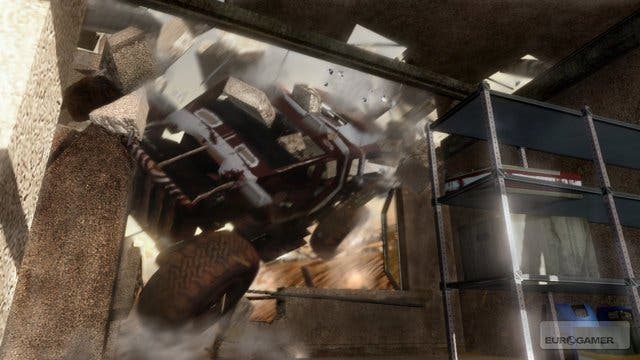Red Faction: Guerrilla
Smash things up like an angry guerrilla.
You may remember Red Faction. Set below the surface of Mars, it used the newfangled technology and unprecedented power of PlayStation 2's Emotion Engine to allow players to blow things up in new and spectacular ways. Red Faction: Guerrilla is set on the surface of Mars and uses the newfangled technology and unprecedented power of the PlayStation 3 and Xbox 360 so that players can blow things up in even newer and more spectacular ways.
Although the original Red Faction was decent enough and allowed unprecedented freedom to blow holes in (some parts of) the scenery, it didn't solve one of the perplexing oddities of first-person shooters: the indestructibility of mission-sensitive objects and items. Consequently, the Geo-Mod technology always seemed a little bit superfluous, because the game trammelled you down an impervious skeletal framework designed to prevent you from Geo-Modding your way past a scripted event or encounter.
To get around this, Red Faction: Guerrilla has abandoned the idea of terrain deformation and replaced it with a destruction system in which buildings and objects are blown up according to the rules of real-world physics. But it marks a return to the milieu of the original Red Faction (and not its Earth-based sequel). In fact, the dusty sands of Mars provide the perfect backdrop to Volition's physics-based destruction system: quite apart from all the conveniently explosive hydrogen canisters dotted around the environment, it simply wouldn't be possible to attain this level of realistic destruction in the sort of densely populated urban environments of, say, Saint's Row.
"The technology here is extreme," explains Volition vice president, Dan Cermak. "It's not cheap. This is very deep. There are a lot of cycles going in to doing this destruction and the physics-based particles." Indeed, in case anyone's in any doubt about quite how much computing it takes to sustain this physics-based system, Volition has got all sorts of demos that show precisely how impressive it is. One shows all of the stress lines used to model the destruction; another shows all of the numbers being calculated to check those stresses while you're playing the game. It's just a screen full of numbers, but it makes the point pretty clearly.

The game, says Cermak, is a result of a decision that the company took a while ago to switch its entire development effort towards creating openworld games. "We thought with maybe a new kind of destruction system and an openworld we'd have something very special. So we decided to take Red Faction and rework it. And we started with the Geo-Mod system saying, 'well this is fine, but it's not good enough for next-gen.' So we started a four-year odyssey of technology development that we've been going through and it ended up with us developing a physics-based destruction system that is far beyond what's currently on the market."
According to Cermak, the current cutting edge of destruction, embodied by games such as Crysis and Mercenaries 2, consists of replacing a model of, say, a pristine-looking building with a few particle effects and then a new, suitably destroyed-looking model of the same building. It's a system he calls "corpse replacement". Guerrilla, by contrast, models the whole thing, using real physics. "This is true physics-based destruction," he says. "Every piece and element that flies off has momentum, it has mass, it can do damage, it can kill you, it can destroy other parts of other buildings, there's a stress system, and a load-bearing system in the world at all times, so buildings are under stress and under load from destruction."
